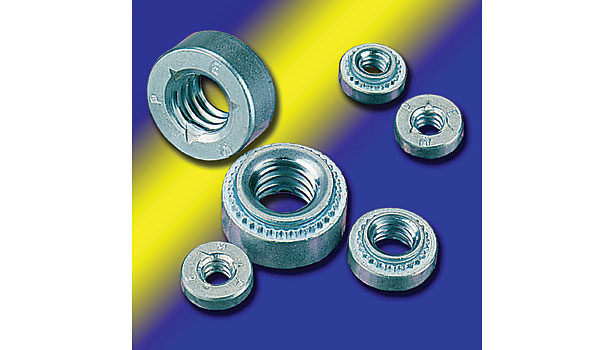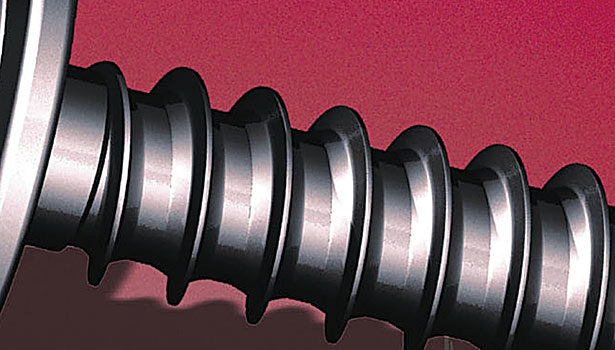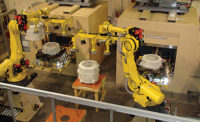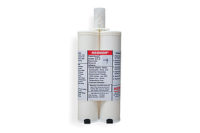Every year, fans of the Winter X games see snowmobile racers battle the elements and the laws of gravity to perform amazing feats—including long distance jumps and double back flips. What the fans don’t see is the ongoing battle between fasteners and vibration within every bolted joint of the snowmobile.
Polaris Industries Inc. is a leading manufacturer of snowmobiles, and it sponsors the Polaris Racing team that participates on the snowcross racing circuit. The team’s members frequently win medals at the X Games and other snowcross events. Polaris’ design engineers always specify the use of Loctite threadlockers on fasteners to keep them secure.
“We apply threadlockers [to fasteners] in all of our SDI engines,” says Jason Miller, snowmobile product manager for Polaris Industries. “A very critical interface is the mount between the engine and chassis, where there is extreme vibration and temperature variation.”
Loctite 242 threadlocker is applied with a hand pump onto the mounts. The pump ensures that assemblers use the correct amount of product. Loctite 243 is applied to the snowmobile’s drive clutch jam nut, as well as the clutch’s spider assembly.
Threadlockers are one of four types of products specifically designed to prevent fastener loosening due to vibration. The other three are specialty screws, bolts and nuts. All of them help keep bolted joints as strong as the day they were first assembled.
Causes and Effects
Although vibration is a common cause of fastener loosening, manufacturers should not assume it is always the cause, recommends Ken Gomes, vice president of engineering and product development for REMINC. Loosening may be the result of lost preload due to embedment, which occurs when the mating metal surface distorts, deforms or dimensionally changes during fastener installation. Embedment causes fastener relaxation, making it prone to failure by fatigue.
Another cause of loosening is differences between the friction coefficients of the joint materials and the threaded fasteners. Any reduction in friction in the threads, underneath the screw head, or at the nut face can lead to a reduction in overall clamping force in the joint.
Bossard North America often tests the fasteners it supplies with Schatz USA’s Analyse tester. This device follows the ISO 16047 international standard to determine several tightening characteristics of mechanical fasteners. These include the total friction coefficient; the friction coefficients of the thread, head or nut bearing surface; preload force at the yield limit; and breaking force. Joe Stephan, application engineer for Bossard, says his company often uses the device to test fasteners it provides to John Deere.
Corrosion, unbalanced loads on a joint, and improper threadlocking patches can cause a fastener to loosen. Patches that break down oxide coatings on stainless steel fasteners and nuts may cause them to gall or cold weld together. If tightening continues once galling begins, the fastener head may twist off or its threads may strip, increasing the possibility of loosening.
A fastener may be subject to one or more types of vibration, including axial, transverse, orbital (offset circular) and random. Depending on the joint, a combination of vibrations may loosen the fastener or have no impact on it. They might even tighten the joint.
Axial or parallel vibration runs along the fastener axis and can reduce preload by 30 to 40 percent over an extended period of time. If such vibration is severe, it can also cause periodic dilation of the nut. Severe transverse vibration, which is perpendicular to the bolt axis, may cause complete loss of preload.
“Vibration impacting a fastener at an exact right angle is the worst,” explains Gomes. “It causes loosening through reverse rotation motion, which is the path of least resistance. Fluctuating vibration is also bad. It continually jabs at the fastener, so to speak, causing it to loosen.”
The Junker test, named after German engineer Gerhard Junker, enables manufacturers to determine the point at which a bolted joint loses its preload when subjected to shear loading caused by transverse vibration. Developed in 1969, the test lasts 62 seconds, during which time a fastener is subjected to 2,000 cycles of transverse vibration. The stroke length of each cycle is equal to 10 percent of the fastener’s diameter. This test is part of international fastener standards DIN 65151 and DIN 25201-4.
Assembled products frequently experience fluctuating vibration while in transit to their end-users. All forms of transportation—vehicle, rail or air—transfer vibration to the products, according to Jarrod Neff, marketing manager for Visumatic Industrial Products. Visumatic specializes in automated fastening systems.
“The truck or plane shakes the crate, and the crate shakes the product inside,” says Neff. “It’s really hard to insulate the product from vibration. So we typically apply a semipermanent Loctite blue threadlocker to each fastener and make a small paint mark to indicate where the top of the bolt head should be when the fastener is properly tightened.”
The ongoing trend toward lighter, smaller products tends to increase the amount of vibration in a joint, claims Gene Simpson, vice president of quality and engineering for Semblex Corp. Simpson says these two trends can sometimes work in tandem with each other. For example, lighter materials vibrate more, while smaller fasteners, in general, can handle less vibration. As a result, fasteners in small, lightweight products are more susceptible to loosening, unless design options are considered to address this risk. Such options could include specialty thread designs, threadlocking materials or locknuts.
Fatigued fasteners can crack—especially those in high-stress joints, and those with inherent microcracks and other imperfections. Such fasteners may propel outward if they break, rather than simply fall to the ground, posing a threat to workers and equipment.
Good Vibration Stoppers
Consumer-electronics manufacturers increasingly prefer specialty micro fasteners, such as Type TA TackPin fasteners, to screws. One manufacturer uses the press-in TackPin fasteners to assemble computer keyboards because they won’t loosen or back out due to vibration, says Doug McLeod, senior application engineer for PennEngineering.
“More than 100 screws, each treated with a threadlocking patch, were manually installed to attach a super thin membrane to a very thin substrate within the keyboard,” explains McLeod. “Now, fewer pins are needed, and installation takes about one minute with an automated machine (the M1500 made by DWFritz Automation Inc.).”
Billions of TapTite and TapTite 2000 thread-forming screws are installed annually, primarily by assemblers at Ford Motor Co., General Motors Corp. and their Tier 1 suppliers. Unlike standard screws, which have tri-lateral-angle threads, these heavy-duty screws feature a trilobular thread body with a triangular cross-section rather than a circular one.
The trilobular shape requires low torque during thread forming. It also generates strong mating threads for high resistance to vibration and stripping. Gomes says the original TapTite screws feature 60-degree threads, although flanks of the threads on the 2000 series feature a convex radius profile that allows thread forming at a lower torque.
REMINC’s FasTite 2000 and Powerlok II fasteners also feature trilobular threads. Optional underhead serrations on the FasTite 2000 increase resistance to loosening and stripping in thin-sheet-metal applications. The Powerlok II’s dual-angle thread form features a 30-degree tip that creates ‘stored energy’ locking. This locking action is unaffected by vibration or temperature. Powerlok II screws are used in threaded nuts.
Another thread-forming screw is the Rolok from Semblex. Each of its threads features three asymmetrical lobes that form mating threads in the nut or nut member.
“Because of its spiral profile body, the fastener engages fully in aluminum C-channels and non-round holes,” says Simpson. “Once installed, its thread geometry has a natural resistance to vibration.”
The screw can be used in steel, aluminum, bronze, brass and any stainless steel with sufficient ductility to form matching threads. Simpson says it is used extensively in a wide range of industries, including auto, electronics, heavy equipment and home entertainment.
For plastic applications, Semblex offers the Delta PT thread-forming screw. Its 30-degree helix angle quickly backs off into a 20-degree angle, permitting unimpeded flow of the plastic during installation. The screw’s flanks create shear areas that produce high clamp loads.
Simpson says the screw’s angled core diameter reduces stress during thread forming, while the low helix angle controls screw back-out in dynamic applications. Both features maximize engagement with the plastic. The overall design enhances joint stability by reducing creep and increasing break-loose torque.
Manufacturers in a wide range of industries—from submarines to furniture—use the Nuts N’ Bolts 434 threadlocker from Hernon Manufacturing Inc. Its thixotropic properties allow easy application, notes Edgardo Rodriguez, director of sales and marketing for Hernon Manufacturing Inc.
The blue threadlocker is well-suited for threaded fasteners and nuts that are plated or made of passive substances like stainless steel. It can be applied to non-pristine surfaces and cures anaerobically. Treated fasteners and nuts can be removed with standard hand tools.
Hernon also custom-formulates threadlockers. Rodriguez says one electronics manufacturer applies a custom threadlocker to fasteners that are used to assemble a specialty consumer radio. For this high-volume application, the threadlocker is formulated to keep fasteners tight in below-freezing temperatures.
In 2010, Henkel Corp. introduced several robust threadlockers based on proprietary research that identified a market need for products that don’t require fastener cleaning or priming. One is Loctite 243, a general-purpose, medium-strength blue threadlocker.
Doug Lescarbeau, market development manager for Henkel Corp., says the primerless threadlocker tolerates minor surface contaminations from various oils, such as cutting, lubrication, anti-corrosion and protection fluids. It performs well on 0.25- to 0.75-inch-wide fasteners in high-temperature environments (up to 180 C). Treated fasteners can be removed with hand tools.
Another robust threadlocker is Loctite 263, which provides permanent locking and sealing. The red product is particularly suited for high-strength applications, such as studs in motor housings and nuts on studs in pump housings. Its viscosity is 450 centipoise.
The company also makes Loctite 2047, a threadlocker specially formulated with additives to match the lubricity normally achieved with metal-free anti-seize lubricants. Its slow cure profile allows torquing of multiple bolts in a single assembly prior to curing. All Loctite threadlockers cure anaerobically.
Self-clinching fasteners are also available with anti-vibration features. Prevailing torque, self-clinching locknuts and nuts from PennEngineering maintain a fastener’s installed torque value regardless of the amount of axial load applied. Type SL locknuts have deformed threads and a Tri-Dent type locking feature that prevents loosening due to vibration. McLeod says automakers use them to secure interior-door components.
Introduced recently, PEM Type LA4 self-clinching floating nuts feature elliptically squeezed threads that adjust up to 0.03 inch to ensure mating hole alignment. LA4 nuts install into thin sheets of stainless steel. Another locking fastener, Type CFN, is designed for close-to-the-edge applications. As the screw enters the CFN nut’s nylon ring (blue or black), interference at the thread’s pitch diameter generates a prevailing torque.
“When critical-application bolts are installed properly, they always stay tight despite extreme ongoing vibration,” concludes Gomes. “If they didn’t, our cars would fall apart as we drove.”
ASSEMBLY ONLINE
For more information on anti-vibration fasteners, visit www.assemblymag.com to read these articles:







